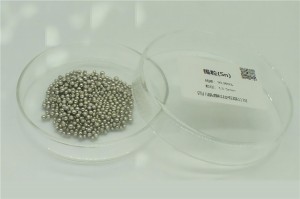Tin is one of the softest metals with good malleability but poor ductility. Tin is a low melting point transition metal element with a slightly bluish white luster .
1.[Nature]
Tin is a carbon family element, with an atomic number of 50 and an atomic weight of 118.71. Its allotropes include white tin, gray tin, brittle tin, and easy to bend. Its melting point is 231.89 °C , boiling point is 260 °C, and density is 7.31g/cm³. Tin is a silvery white soft metal that is easy to process. It has strong ductility and can be stretched into wire or foil ; it has strong plasticity and can be forged into various shapes.
2.[Application]
Electronics industry
Tin is the main raw material for making solder, which is an important material for connecting electronic components. Solder is composed of tin and lead, of which the tin content is generally 60%-70%. Tin has a good melting point and fluidity, which can make the welding process easier and more reliable.
Food Packaging
Tin has good corrosion resistance and can be used to make food cans, tin foil, etc. Food canning is a method of preserving food by sealing it in a tin can. Tin cans have good sealing properties and can prevent food from spoiling. Tin foil is a film made of tin foil, which has good corrosion resistance and thermal conductivity and can be used for packaging food, baking, etc.

Alloy
Tin is an important component of many alloys, such as bronze, lead-tin alloy, tin-based alloy, etc.
Bronze: Bronze is an alloy of copper and tin, with good strength, hardness and corrosion resistance. Bronze is widely used in the manufacture of clocks, valves, springs, etc.
Lead-tin alloy: Lead-tin alloy is an alloy composed of lead and tin, with good melting point and fluidity. Lead-tin alloy is widely used in the manufacture of pencil leads, solder, batteries, etc.
Tin-based alloy: Tin-based alloy is an alloy composed of tin and other metals, which has good electrical conductivity, corrosion resistance and oxidation resistance. Tin-based alloy is widely used in the manufacture of electronic components, cables, pipes, etc.
Other areas
Tin compounds can be used to make wood preservatives, pesticides, catalysts, etc.
Wood preservatives: Tin compounds can be used to preserve wood, preventing it from rotting.
Pesticides: Tin compounds can be used to kill insects, fungi, etc.
Catalyst: Tin compounds can be used to catalyze chemical reactions and increase reaction efficiency.
Crafts: Tin can be used to make various handicrafts, such as tin sculptures, tinware, etc.
Jewelry: Tin can be used to make various jewelry, such as tin rings, tin necklaces, etc.
Musical instruments: Tin can be used to make various musical instruments, such as tin pipes, tin drums, etc.
In short, tin is a metal with a wide range of uses. The excellent properties of tin make it important in the electronics industry, food packaging, alloys, chemicals and other fields.
Our company’s high-purity tin is mainly used for ITO targets and high-end solders.
Post time: Jun-14-2024


